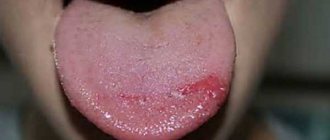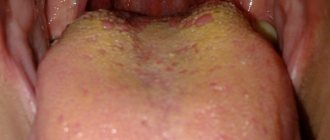Causes of bowel dysfunction in infants
The reasons for the appearance of blood in the stool may not be immediately established. In some cases, bleeding is caused by serious dysfunction of internal organs. The examination requires an integrated approach.
Black spots
The appearance of small dark dots or black threads in a baby is usually observed on the third day of his life. The phenomenon is explained by the emptying of the stomach from original feces - meconium. It has a viscous and sticky consistency. Original feces contain digested baby hair, amniotic fluid, mucus, epithelial cells, as well as a small amount of lactobacilli, which produce lactic acid and participate in the formation of fetal immunity.
In most cases, feces with dark spots do not signal any pathology. If parents notice inclusions of black threads, then it is necessary to monitor the baby’s nutrition and behavior. Often, when getting acquainted with the outside world, a child puts various foreign objects in his mouth. Ingestion of fur, dust and hair can cause not only black stools, but also dyspepsia, which is characterized by bloating.
From the age of six months, fruits and vegetables are added to the diet, which change the color of the stool. For example, a child may develop black threads after eating bananas. This is due to the lack of necessary enzymes when digesting this product. By the age of one year, the stool is formed, acquiring a natural brown color and uniform consistency.
This condition may indicate internal bleeding in one of the parts of the gastrointestinal tract. Stomach ulcers, colitis, and varicose veins of the digestive system can also be a provocateur.
Red veins
Streaks of blood in the stool of a baby may appear regardless of the nature of the diet. If blood or bloody streaks resembling snot are found in the stool, then this symptom may indicate certain diseases.
The following reasons can be identified:
- Constipation.
- Sores around mother's nipples. When breastfeeding, the baby swallows the blood released from the nipples.
- Wounds and cracks in the baby's anus.
- Atopic dermatitis. With this pathology, the intestinal mucosa becomes covered in a rash and bleeds.
- Imbalance of intestinal microflora. Bloody mucus will be released in the stool.
- An allergic reaction to the protein contained in milk. In this case, stool disturbance is accompanied by vomiting. Protein can enter a child's body through formula or from breast milk. Usually there is peeling, rash and redness. The child's appetite decreases. This condition causes anemia.
- Inflammatory processes in the intestines. In this case, blood clots do not mix with feces, and the stool acquires a liquid consistency. The child has vomiting and loss of appetite.
- Intestinal infection. Body temperature rises.
- Pathological processes in various parts of the intestine. There is an increase in temperature and a decrease in appetite. The child is bothered by pain in the abdominal area.
- Low levels of vitamin K, which is responsible for blood clotting.
- Damage to the body by helminths. In addition to spotting, there is weight loss and rashes on the body.
- Polyps in the intestines. This condition is accompanied by bleeding. Sometimes blood is not released with the stool. It is detected during testing.
- Lactose deficiency. The child's body contains the enzyme in small quantities. An admixture of blood and mucus, as well as lumps of milk, is found in the stool. The child becomes capricious and lethargic.
We invite you to familiarize yourself with White bugs in the bathroom: 4 effective ways to combat.
If there is any violation of the consistency of the stool, you should immediately contact a specialist. The doctor will conduct appropriate diagnostics and prescribe appropriate treatment.
Green grains
Typically, the stool of a baby who is fed breast milk has a brownish tint with white grains. An admixture of mucus and a sour smell are acceptable. Sometimes the stool becomes foamy and greenish in color.
The reasons for coloring green are as follows:
- oxidation of feces in air;
- consumption of certain foods by a nursing mother (cucumbers, zucchini, lettuce);
- taking certain medications;
- the baby has dysbacteriosis, which is characterized by a violation of the intestinal microflora;
- release of bilirubin.
Green stool in itself may not be a sign of pathology. But consultation with a specialist is required, since a greenish tint in some cases indicates a disease in the child.
Black feces along with other symptoms of ill health
If there is an existing pathology, other symptoms should also be expressed. It is impossible to draw a conclusion based solely on the presence of bloody, dark or green stools.
You should contact a specialist if your baby is concerned about:
- cracks and abrasions in the anus;
- vomit;
- increased body temperature;
- diarrhea.
Doctors also note that the trigger mechanism can be the presence of polyps, hemorrhoids, dysbacteriosis, enterobiasis or ascariasis in the intestines.
A change in the color of stool and the appearance of various inclusions and stripes in it may indicate the presence of diseases. In this case, the child develops other symptoms against the background of darkening of the feces. In this case, it is necessary to seek help from a doctor in order to promptly diagnose the disorder and begin the necessary treatment. Ignoring the signs can negatively impact your digestive system and overall health.
Gastrointestinal diseases
Symptoms of digestive diseases:
- colic and cramping in the abdomen;
- heat;
- flatulence;
- diarrhea interspersed;
- vomiting and regurgitation;
- lack or decreased appetite;
- weakness;
- feeling of discomfort in the anal area.
These symptoms appear with stomach and duodenal ulcers and other inflammations. It is necessary to consult a doctor to confirm or exclude the diagnosis.
The pancreas and liver produce enzymes that promote rapid digestion of food. The appearance of black stool with mucus may indicate cirrhosis or hepatitis. At the beginning of the disease, the feces are white, then become very dark. With pathology of the pancreas, there are inclusions in the stool, and the stool takes on a gray tint.
Internal bleeding occurs when the walls of the digestive organs are damaged. It can be caused by inflammatory processes or the entry of a foreign object. The excrement turns black due to the specific effect of gastric juice on the blood. During the reaction, it oxidizes and the feces become dark in color. If blood appears in the lower parts of the digestive system, it comes out unchanged, and the baby develops red stool.
We invite you to familiarize yourself with Red bugs with black spots on their wings
Is this the norm?
For young children this is a normal physiological process. During the period of intestinal formation, a child’s stool varies. The appearance of blackheads is normal. Especially during the feeding period.
Over time, the body gets used to certain foods and the digestive system completely digests them with age.
The presence of black threads in the stool does not require visiting a doctor and treatment if the child feels well. Otherwise, you need to call a doctor, since the cause may not be the black threads.
netparazitam.com
What to do if detected
You should monitor the child’s well-being and adequately assess his physical condition. Even if the bloody streaks in the stool are insignificant, you need to play it safe and show the baby to the pediatrician.
Adequate treatment is not prescribed in absentia. If an infection is detected in the stool, antimicrobial and antibacterial drugs are prescribed.
If a change in the color of stool is caused by an allergy to food, then the allergen should be identified and excluded from the diet. Streaks of blood in the stool should not cause concern if a nursing mother is not eating properly. The baby's mother should include dried apricots, fermented milk products in her diet, and drink more water. But consultation with a doctor on this matter is mandatory!
Komarovsky's advice
Komarovsky notes that most often the appearance of bloody streaks is accompanied by a change in the color of feces and their consistency. Dark stool may indicate the presence of stomach bleeding.
Common causes of blood in a baby's stool are injuries to the anus. Damage occurs due to intestinal obstruction. Pediatrician Komarovsky advises adjusting the baby’s diet, as well as taking measures to increase intestinal tone. For this purpose, he recommends giving the baby a massage, as well as using therapeutic exercises that involve bending and straightening the legs.
Dark stool with bloody spots makes parents worry. Sometimes there is indeed a reason to visit the pediatrician, but often the symptom is harmless and the baby is completely healthy.
Diagnostics
The reason for the appearance of inclusions in the child’s feces is determined through laboratory tests. First of all, an examination by a specialist is necessary.
Diagnostic measures involve visiting doctors of various specialties:
- Pediatrician. He will prescribe tests and give referrals to specialized specialists.
- Allergist. A visit to a specialist is indicated if there are skin rashes and signs of atopic dermatitis. Your doctor will be able to determine the cause of your food allergy.
- Gastroenterologist. He will be able to eliminate the possibility of bleeding in the upper parts of the stomach, as well as pathology of the digestive system.
- Hematologist. Consultation with a specialist is indicated if a bleeding disorder is suspected.
In addition to consulting doctors, various tests are recommended. Laboratory research methods are accurate and help prescribe the right treatment.
The following laboratory tests are carried out:
- Analysis for lactose deficiency. It can reveal the amount of enzyme that is not absorbed by the baby's body. Digestive disorders provoke bloating, colic, and the appearance of blood in the stool. The test results will allow you to prescribe the required dose of enzymes.
- Analysis for the presence of dysbacteriosis. Sowing for dysbacteriosis reflects the composition of the flora and reveals the presence of pathogenic pathogens.
- Analysis for the presence of internal parasites. Helps identify helminthic infestations.
Experts assess the presence of bloody streaks in stool as a complex case in clinical practice, which is difficult to diagnose. Sometimes during examinations, hidden blood is revealed in the baby’s stool, which cannot be seen.
The causes of hidden blood in a child’s stool can be very serious:
- helminthic infestation;
- polyps;
- colitis;
- stomach ulcer.
We suggest you read: Bed bugs: where they live and how long they live without food
Before taking the test, special preparation is required, which is carried out within three days. Meat products, cauliflower, and cucumbers are excluded from the child’s diet. Stop taking ascorbic acid, drugs containing iron, as well as non-steroidal anti-inflammatory drugs.
Why do pinworms appear in feces?
Enterobiasis is a parasitic infection that can be contracted in several ways. Mature parasite eggs enter the digestive system along with unwashed vegetables, through household items and through hands after a child comes into contact with a sick person. With enterobiasis, there is a high probability of self-infection, which is explained by the peculiarities of the development of eggs and larvae.
An individual pinworm was found in feces.
Pinworm eggs that enter the digestive system enter the small intestine, where they mature in a few hours and the larva emerges. The young individual receives nutrients from the intestinal walls and after about two weeks it turns into a full-fledged pinworm. Adults mainly live in the upper parts of the large intestine. The female with the eggs descends lower and when the sphincter relaxes, which happens at night, she comes out and leaves a clutch in the folds around the anus.
Pinworms appear in feces precisely when adult nematodes are in the large intestine. The release of large numbers of parasites in feces can be caused by taking antiparasitic or laxative drugs. In this case, the parents discover a moving white lump of worms in the child’s stool. Sometimes parasites can be seen near the anus or on a child's underwear - these are adult females that have left the rectum to lay eggs.
What should normal stool look like in a newborn, infant, or preschooler?
The consistency of stool, its density and color change with the age of the baby. This is explained by the structure of the digestive system, the quality of digestion and metabolic processes, and also depends on the food eaten. The nature of the excrement can indicate the state of health, so it is important to monitor changes in the stool.
During intrauterine development, the baby's digestive system does not function. He receives all the substances necessary for growth through the umbilical cord. After birth, the work of the digestive organs begins. In the first days of life, the stool of newborn children is a dark viscous mass - meconium.
https://www.youtube.com/watch?v=WfohinQPMIA
The stool of a child under 6 months is a light-colored liquid paste. The excrement of breastfed babies and formula-fed babies differs.
Breast milk is completely suitable for feeding a newborn. It changes the composition depending on the needs of the baby. It is worth noting that white grains and lumps in the stool of a breastfed baby are not a cause for concern. It's just undigested milk fat.
Many mothers begin to worry when they see greenish foamy stools that look like diarrhea in their baby. In this case, it is necessary to reconsider the feeding technique. The fact is that the so-called foremilk, located in the breast closer to the nipple, is more liquid and contains fewer nutrients. Hind milk is more nutritious and thick.
The feces of formula-fed babies are thicker and darker. After switching to regular food at the age of 2–3 years, children's feces take on the appearance of adult feces. The digestive organs begin to work at full capacity.
When should you not worry?
When breastfeeding, there are several options for normal stool color and consistency. Even the absence of bowel movements for 24 hours is not considered constipation if the stool looks like a yellow, soft porridge. In fact, the color of stool may change for the following reasons:
- Products in the diet of a nursing woman. If the mother’s menu the day before included tomatoes, beets, and black currants, the baby’s stool may turn reddish. But this does not mean at all that the baby has bloody stool.
- Taking medications. If the mother takes antibiotics, medications containing iron, or tablets containing dyes, the color of the baby's stool will certainly change.
- Introduction of complementary foods. When a child is introduced to a new food, changes occur in his digestive system, including stool. This should not cause concern to the mother.
Treatment
Treatment depends on the cause of the change in stool color. If it is caused by exposure to allergens, then it is advised to feed the baby with formulas that do not cause allergies. If there is no effect, the child is transferred to hydrolysates. The doctor selects the optimal mixture.
If the intestines are infected, antibacterial agents are prescribed. The sensitivity of the bacteria to the antibiotic must be determined. Symptomatic treatment is also carried out, involving the use of detoxification, drugs that stop bleeding, and enzyme-based drugs.
If colitis is diagnosed, a special diet is prescribed. Antibiotics, phages, and enterosorbents are also used.
If cracks are detected in the anus or hemorrhoids, special rectal suppositories, baths, and microenemas based on rosehip or sea buckthorn oil are prescribed. Chamomile infusion is used.
An important point is the prevention of constipation. Surgical treatment is indicated when polyps are detected in the intestinal area.










